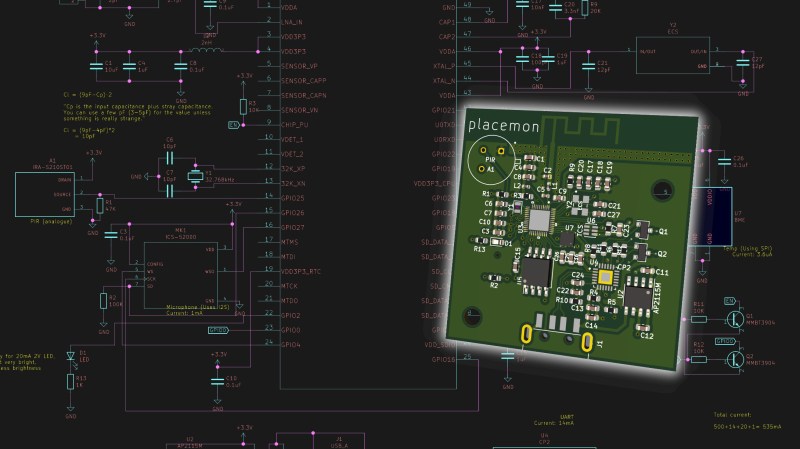No, no, at first we thought it was a Pokemon too, but Placemon monitors your place, your home, your domicile. Instead of a purpose-built device, like a CO detector or a burglar alarm, this is a generalized monitor that streams data to a central processor where machine learning algorithms notify you if something is awry. In a way, it is like a guard dog who texts you if your place is unusually cold, on fire, unlawfully occupied, or underwater.
[anfractuosity] is trying to make a hacker-friendly version based on inspiration from a scientific paper about general-purpose sensing, which will have less expensive components but will lose accuracy. For example, the article suggests thermopile arrays, like low-resolution heat-vision, but Placemon will have a thermometer, which seems like a prudent starting place.
The PCB is ready to start collecting sound, temperature, humidity, barometric pressure, illumination, and passive IR then report that telemetry via an onboard ESP32 using Wifi. A box utilizing Tensorflow receives the data from any number of locations and is training to recognize a few everyday household events’ sensor signatures. Training starts with events that are easy to repeat, like kitchen sounds and appliance operations. From there, [anfractuosity] hopes that he will be versed enough to teach it new sounds, so if a pet gets added to the mix, it doesn’t assume there is an avalanche every time Fluffy needs to go to the bathroom.
We have another outstanding example of sensing household events without directly interfacing with an appliance, and bringing a sensor suite to your car might be up your alley.




















I need this to monitor my well pump water pressure & frequency of running the pump. The last time my foot valve rusted out my pump ran for a while until I noticed we had no water pressure. Pump was scorching hot with no water flow to cool it it would have eventually melted down.
I’m surprised your well doesn’t have a pressure transducer to turn it off if the pressure is too low or high. Especially if you have it on a VFD? The VFD should be able to do that for you. But if its a simple triac speed controller maybe not.
Here is a friendly option for you that has 2x relay functions built it. You can also set it up with a window function in addition, or instead of rather, a hysteresis function.
https://www.automationdirect.com/adc/shopping/catalog/process_control_-a-_measurement/pressure_sensors/digital_pressure_switches_-z-_transmitters/eps25-v145-1003
Do they include lubricant to ease a privacy violation?
I thought Alexa was bad, but this?
Isn’t the implentation up to you in this case? (By all means break out the KY if necessary…)
If you’re worried about privacy, set up an offline network.
I have cheap Chinese security cams, and there’s no way I’m putting those on my main router.
They’re segregated, “offline”, and recorded to a local box with no outside connection.
That’s what I’ve also done with my Chinese IP-cameras. I did inspect their traffic when I got them and sure enough, they try a billion different ways of letting people in, but they still work perfectly well as IP-cameras even if confine them, so…
If I could be arsed to, I’d modify the firmware, but just confining them was so much easier quicker done that I’ve yet to get around to it.
As long as there’s the legal right to it when you do need it, and the technical capability to make it happen (Like by turning off devices, or using encryption), I don’t see why we should let it limit our technology.
Surveillance cameras in busisnesses are great, most of us probably don’t want warrantless wiretaps. There needs to be a distinction between real privacy violation, and obvious data collection that’s right there in the terms of service, which people opt in to.
Sounds like a job for machine learning.
Actually sounds pretty good. It learns typical data patterns and alerts you if something is outside the expected.
I’m too lazy to read the details, but I wonder how it gets taught. In typical machine learning classifiers, you need to have samples from both categories: normal data, and unexpected data. I guess fire alarm sounds are easy enough to teach, but how about flood damage or actual fire?
PERFECT for TinyML, look up edgeimpulse.com